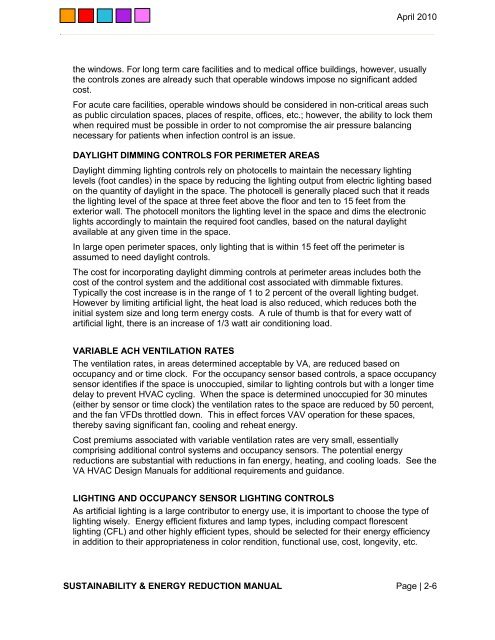Sustainability Design and Energy Reduction Manual - The Whole ...
Sustainability Design and Energy Reduction Manual - The Whole ...
Sustainability Design and Energy Reduction Manual - The Whole ...
Create successful ePaper yourself
Turn your PDF publications into a flip-book with our unique Google optimized e-Paper software.
April 2010<br />
the windows. For long term care facilities <strong>and</strong> to medical office buildings, however, usually<br />
the controls zones are already such that operable windows impose no significant added<br />
cost.<br />
For acute care facilities, operable windows should be considered in non-critical areas such<br />
as public circulation spaces, places of respite, offices, etc.; however, the ability to lock them<br />
when required must be possible in order to not compromise the air pressure balancing<br />
necessary for patients when infection control is an issue.<br />
DAYLIGHT DIMMING CONTROLS FOR PERIMETER AREAS<br />
Daylight dimming lighting controls rely on photocells to maintain the necessary lighting<br />
levels (foot c<strong>and</strong>les) in the space by reducing the lighting output from electric lighting based<br />
on the quantity of daylight in the space. <strong>The</strong> photocell is generally placed such that it reads<br />
the lighting level of the space at three feet above the floor <strong>and</strong> ten to 15 feet from the<br />
exterior wall. <strong>The</strong> photocell monitors the lighting level in the space <strong>and</strong> dims the electronic<br />
lights accordingly to maintain the required foot c<strong>and</strong>les, based on the natural daylight<br />
available at any given time in the space.<br />
In large open perimeter spaces, only lighting that is within 15 feet off the perimeter is<br />
assumed to need daylight controls.<br />
<strong>The</strong> cost for incorporating daylight dimming controls at perimeter areas includes both the<br />
cost of the control system <strong>and</strong> the additional cost associated with dimmable fixtures.<br />
Typically the cost increase is in the range of 1 to 2 percent of the overall lighting budget.<br />
However by limiting artificial light, the heat load is also reduced, which reduces both the<br />
initial system size <strong>and</strong> long term energy costs. A rule of thumb is that for every watt of<br />
artificial light, there is an increase of 1/3 watt air conditioning load.<br />
VARIABLE ACH VENTILATION RATES<br />
<strong>The</strong> ventilation rates, in areas determined acceptable by VA, are reduced based on<br />
occupancy <strong>and</strong> or time clock. For the occupancy sensor based controls, a space occupancy<br />
sensor identifies if the space is unoccupied, similar to lighting controls but with a longer time<br />
delay to prevent HVAC cycling. When the space is determined unoccupied for 30 minutes<br />
(either by sensor or time clock) the ventilation rates to the space are reduced by 50 percent,<br />
<strong>and</strong> the fan VFDs throttled down. This in effect forces VAV operation for these spaces,<br />
thereby saving significant fan, cooling <strong>and</strong> reheat energy.<br />
Cost premiums associated with variable ventilation rates are very small, essentially<br />
comprising additional control systems <strong>and</strong> occupancy sensors. <strong>The</strong> potential energy<br />
reductions are substantial with reductions in fan energy, heating, <strong>and</strong> cooling loads. See the<br />
VA HVAC <strong>Design</strong> <strong>Manual</strong>s for additional requirements <strong>and</strong> guidance.<br />
LIGHTING AND OCCUPANCY SENSOR LIGHTING CONTROLS<br />
As artificial lighting is a large contributor to energy use, it is important to choose the type of<br />
lighting wisely. <strong>Energy</strong> efficient fixtures <strong>and</strong> lamp types, including compact florescent<br />
lighting (CFL) <strong>and</strong> other highly efficient types, should be selected for their energy efficiency<br />
in addition to their appropriateness in color rendition, functional use, cost, longevity, etc.<br />
SUSTAINABILITY & ENERGY REDUCTION MANUAL Page | 2-6

















